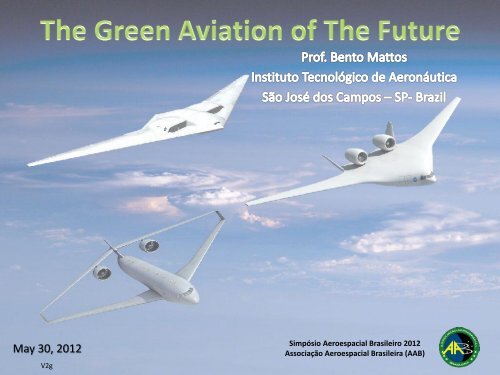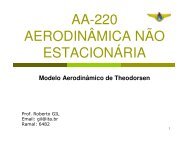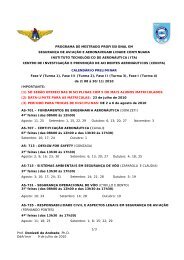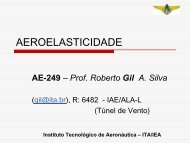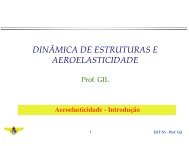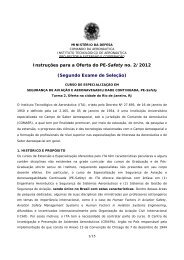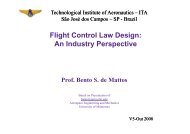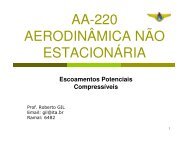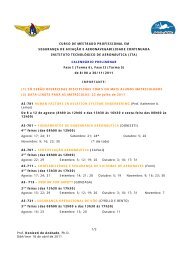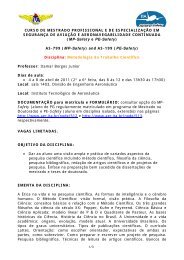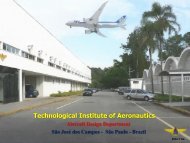May 30, 2012
May 30, 2012
May 30, 2012
- No tags were found...
Create successful ePaper yourself
Turn your PDF publications into a flip-book with our unique Google optimized e-Paper software.
<strong>May</strong> <strong>30</strong>, <strong>2012</strong>V2gSimpósio Aeroespacial Brasileiro <strong>2012</strong>Associação Aeroespacial Brasileira (AAB)
• Quotes• Look into the past Open source philosophy Junkers flying wing VTOL aircraft Tilt-rotor and tilt-wing aircraft Technological development in the last 40 years• World of today A380 technology content Airbus Neo vs. Boeing MAX Agusta-Westland Civil Tiltrotor Compound helicopters• The shape of things to come Global warming Electric road vehicles Alternate fuels Quantum computing ERA CleanSky Wing in ground effect vehicles• Concluding remarksFuture of Aviation
Future of Aviation
The energy produced by the breaking down of the atom is a verypoor kind of thing. Anyone who expects a source of power fromthe transformation of these atoms is talking moonshineIn 1909, two researchers in Ernest Rutherford's laboratory at theUniversity of Manchester, Hans Geiger and Ernest Marsden, fired abeam of alpha particles at a thin metal foil. Alpha particles had beenidentified and named (they were called "alpha rays" to begin with) adecade earlier by Rutherford, as one of the types of radiation given offby radioactive elements such as uranium. Being fast-moving andpositively charged (they're now known to be high-speed heliumnuclei), Rutherford reasoned they'd serve as a good probe of theatomic structure of matter.
There will be years – not in my time – before a womanwill become Prime Minister
640 K ought to be enough for anybodyThe Internet?We are not interested in it
Schiff is one of a minority of economists credited with accurately predicting the financial crisis of 2007–2010. While "nearly all[macroeconomists] failed to foresee the recession despite plenty of warning signs," Schiff is described as detailing specific issues within theeconomy and how they would result in recession.Specifically, Schiff described particular individual facets such as the housing bubble and resulting subprime mortgage crisis, the automotiveindustry crisis and the banking and financial market collapse; however, the profitability of Schiff's advisement has received scrutiny. Onedispute involved Michael Shedlock, economic blogger and investment advisor representative for a rival asset management firm, who statedthat "I have talked with many who claim they have invested with Schiff and are down anywhere from 40% to 70% in 2008"; Shedlock'sstatements prompted the Director of Communications at Schiff's investment firm to respond, "While it is true, that our accounts havesuffered badly in 2008, a fact that we have never disputed or ran from, [Shedlock's] estimates for the size our of typical client losses areexaggerated and unfair."Schiff personally responded to Shedlock's criticism by saying, "to examine the effectiveness of my investment strategy immediatelyfollowing a major correction by looking only at those accounts who adopted the strategy at the previous peak is unfair and distortive," andcalled Shedlock's blog entry "nothing more than an overt advertisement (and a highly deceptive one at that) to use my popularity toadvance his career." He added that losses were felt mostly by recent clients and not by others. In a November 2009 videoblog, Schiff saidthat five stocks he picked for Fortune Magazine in January 2009 had gained a total of 360%.Much of the broker's notoriety for the accurate predictions came from a video entitled "Peter Schiff was right" that was uploaded to thepopular video sharing site YouTube in late 2008 and again in 2009, and subsequently went viral and garnered hundreds of thousands ofviews over the next few months. The video consists of a compilation of clips of his many appearances on various financial news programsfrom networks including CNBC, Fox News, MSNBC and Bloomberg, most of which took place from 2005-2007. In the segments Schiffexplains specifically the fundamental problems he saw with the United States economy and the results they would ultimately lead to. Inmany cases the conversations led to debates in which other talking heads openly laughed at Schiff's assessments, stating they had no ideawhat he was talking about.Schiff's constant warnings of a coming economic collapse earned him the moniker "Dr. Doom."
Future of Aviation
Future of AviationFrom 1 st Century BC to the 9th Century ADFall of Roman Empire1 - Number of shipwrecks: From the peak of 180 shipwrecks in the 1st centuries BC and AD to only 2 inthe 8th century. Decrease of 99%.2 - Levels of lead pollution/production: Estimates of the level of lead production show a decline from80,000 tons per year in the 1st century AD to 4,000 tons in the 9th century. Decrease of 95%.3 - Copper pollution: Also show a decline from emissions of 2,<strong>30</strong>0 tons per year in the 1st century to<strong>30</strong>0 tons per year in the 9th century. Decrease of 85%.4 - Animal bones: The number of animal bones found by archaeologists in the areas corresponding tothe provinces of the Roman Empire show a decline from the high of 250,000 bones in the 2nd centuryto a low of less than 10,000 bones by the 8th century. Decrease of 97%.Today there is no way to deny the social/economic collapse that occurred over all of western Eurasiafrom the 2nd to the 8-9th centuries.It is a rather unique event in world history: a continuous process of decline in social complexityspanning over several centuries, from around 150 CE to 750 CE. While civilizations had collapsed beforethis long process of slow decline is rather unique.Source: http://www.historium.com
Future of AviationOpen-Source Aviation Ambience in EuropeTissandier Brothers - 1883The brothers Albert and Gaston Tissandier ofFrance designed and constructed the first airshippowered by electricity. The current was suppliedby 24 bichromate of potash cells to a Siemens 1.5horsepower (1.1 kilowatts) at 180 revolutions perminute. The engine drove a large two-bladedpusher propeller through reduction gearing. Thespeed achieved in calm air was still only 3 milesper hour (4.8 kilometers per hour) since the ratioof power to weight was no better than Giffard'shad been. It can be clearly observed the influenceof Tissandier airship configuration on the design ofSantos-Dumont no. 3. That can be credited to thecollaborative ambience that prevailed incontinental Europe at that time.• Very similar to Tissandier’s airship• First fully operational in historySantos-Dumont No. 3
Open-Source Aviation Ambience in Europe14BisVoisin’s GliderSantos-Dumont
Open-Source Aviation Ambience in EuropeDemoiselle and Blériots – Airshow in Texas inJanuary 1911
USA lag behind Europe at the Beginning of WWISource: Angelucci, Enzo. Illustrated Encyclopedia of Military Aircraft. Edison: Chartwell Books, 2001.
Open-Source Aviation Community in EuropeOpen-Source Strategy is a Success Formula TodayLinuxWikipediaThe free encyclopediaFirst practical airplane is a product ofexchange of ideasConcorde: Collaborative work
Junkers G 38The Junkers G. 38 is a very large all-metal commercial monoplanefitted with four 750-hp Junkers Jumo 204 Diesel engines andhaving the unusual feature of accommodation for passengers inthe wings. It carried a total of thirty-four passengers, six beingseated in two compartments in the leading-edge of the wing. Twopassengers are seated in the nose of the fuselage and theremainder in cabins arranged on two decks. There is a smokingsaloon aft. The G. 38, which was used by Deutsche Lufthansa oncertain European services, had a MTOW of 52,900 lb and a cruisingspeed of 129 mph.16
Junkers J 1000Another futuristic design was the J1000 developed in 1924. This design was developed specially for Hugo Junkers' travel to theUnited States. Junkers and Zindel presented the J1000 design as a probable future transport aircraft, which was also usable as atransatlantic aircraft for passengers. Routings over Iceland, Greenland and Canada were already discussed by Junkers. The designwas a wing only canard solution. Accommodation for up to 80 people were fully integrated in the wing. Individual sleeping cabinswere also available for long range flights of 8 to 10 hours. The design was highly futuristic for its time and it is uncommon untiltoday. For his commercial presentations of the J.1000 design, Junkers had prepared a model aircraft, as well as a lot of technicaland art drawings. Also a mockup of the passenger areas in the wing were already built at Dessau. It is unknown, if Junkers andZindel believed to present a realistic design for the mid twenties or if they just like to show, what will be possible in the future of airtransport. However, their U.S. discussion partners did not show highly interest in the J.1000 design and no further developments ofthis project are known. Nevertheless, a lot of concepts of the Junkerssime and the J.1000 were later used by Junkers in the G38development, which became the largest landbased aircraft of its time.17
Transatlantic Regular Flights with AirshipsHindenburgLZ 127 Graf Zeppelin
Boeing 247 – Manufacturer was already concerned about aircraftgenerated noiseFirst of the modern airliners, the Boeing 247 first flew in February of 1933. The all-metal,low-wing 247 combined a retractable landing gear, two supercharged air-cooled engines,and, in later models, controllable pitch propellers, with totally new standards in passengercomfort. The ten passengers and three crew members enjoyed excellent soundproofing, alow vibration level, plush seats, and, for the first time, cabin air conditioning. Boeing's 247also featured a working galley, provisions for a flight attendant and even an onboard toilet.It set the 247 in a class apart in the early 19<strong>30</strong>s.
Future of AviationVTOL Aircraft20
Tilt-rotor and Tilt-wing AircraftTranscendental 1-G (1954)Bell XV-3 (1955)Vertol NASA Tilt-wing (1959)Boeing Vertol 56/VZ-2 (1955)Doak VZ-4 (1958)Hiller X-18 (1959)Kaman K-16 (1962)Curtiss-Wright X-19 (1964)Curtiss-Wright X-100 (1960)
Tilt-rotor and Tilt-wing AircraftLing-Temco-Vought XC-142ª (1964)Canadair CL-14 (1955)Bell X-22 (1966)Nord 500 (1968)VFW VC-400 (1968) – Never flewBell/Boeing V-22 Osprey(1989)Bell <strong>30</strong>1/XV-15 (1980) Bell/Agusta BA609 (1999)
Compound HelicoptersLockheed Cheyenne
Airbus concept for the A380 Airliner (year 2000)Two A-<strong>30</strong>0 fuselage sections joined by plain segmentsNo wingtipsDrawback: anydoor in thisregion is costlyto manufactureSame front fuselage from older versions (reduce costs)Source: Airbus24
Post-war advances in technology have been slowPast... and more recentlyRocket plane X-156000 km/h1960sSpaceshipOne<strong>30</strong>00 km/h2004xSupersonic airliner Concorde1969Nothing comparable
Post-war advances in technology have been slowPast... and more recentlyManned missions to moonApollo 171972xMankind did not come back to moonwith manned missions since Apollo 17Bathyscaph Trieste IIReached a depth of 10.911 m1960, Marianas TrenchesNereus became the first unmanned submarineto reach the Marianas Trenches. This wasaccomplished in 1998. In <strong>2012</strong>, filmmakerJames Cameron performed record-breakingMarianas Trench dive.
World of Today27
Future of AviationExamples of Innovations Applied to A380Source: Airbus
Future of AviationExamples of Innovations Applied to A380Flight PhysicsSource: Airbus
Future of AviationExamples of Innovations Applied to A380Center Wing BoxSource: Airbus
Max vs. NeoBoeing 737MAXAirbus A320NeoWhen Southwest Airlines announced the first firm orderfor the re-engined Boeing 737 MAX, it represented thelatest in a series of back and forths between Boeing andAirbus regarding their re-engine programs of the 737NGand Airbus A320 family respectively.Early 2011, speaking at the Credit Suisse AerospaceConference, Airbus' Chief Operating Officer -Customers, John Leahy dismissed the Boeing 737 MAX,stating that the Airbus A320Neo family of aircraft willbeat the Boeing 737 MAX's fuel burn by up to 11% (on aper-seat basis), with each member of the family outperformingits direct Boeing competitor. Leahy furtherquestioned the validity of Boeing's claims regarding thecurrent generation 737-800, claiming that Boeing'smetric of using total cash ownership costs (includingownership costs) is heavily subject to manipulation.Meanwhile, in announcing the order from SouthwestAirlines, Boeing continued to assert the 737 MAX'ssuperiority, claiming that fuel burn per seat would bereduced by 10-12% with the 737-8 MAX achieving a 7%advantage in total cash ownership costs (per seat).
Max vs. Neo
Max vs. NeoSource: Airbus
BA609 – Jane’s All of the World AircraftBA609 Tilt RotorCostsUSD 29 million (estimated, 2010).Design FeaturesCombines the most favorable aspects of helicopter and airplane performance in passenger-carrying role. T tailconfiguration instead of endplate fin layout used by earlier tiltrotor designs (XV-15 and V-22 Osprey); this raiseshorizontal tailplane above rotor wake to minimize fore and aft pitching moment at transition phase of flight. Size ofwing determined by requirement for it to hold all fuel for CG and safety considerations. Composites cross-shafts keepboth proprotors turning in event of engine failure. Manual screwjack facility exists whereby the proprotors can betilted into helicopter mode if cross-shafts fail. Designed using three-dimensional CATIA digital computer designsystem. Airframe has design life of 20,000 flight hours.Flying ControlsBAE Systems triplex digital fly-by-wire flight control system, with Dowty Aerospace actuators. T tail with conventionalelevators; no rudder. Two-segment trailing-edge flaperons.StructureAluminum fuselage structure with composites skinning; composites wing. Production fuselages, including cockpit,cabin and systems installation, will be built by risk-sharing partner Fuji Heavy Industries of Japan, which may alsoestablish a third production line if substantial orders are won from the Japanese government; cabin doors andfuselage tailcone supplied by Kawasaki; wing and nacelles by Bell at Fort Worth, with final assembly line at new Belltiltrotor manufacturing facility in Amarillo, Texas and at Agusta facility in Italy. Fuselage in three major sections; nose,center and tail, with fuselage skin incorporating graphite stringers with Japanese Toray composites material. Sameused for wing and nacelles, with upper and lower wing surfaces produced as single pieces.
BA609 – Jane’s All of the World AircraftBA609 Tilt RotorLanding GearRetractable tricycle type, with twin nosewheels and single wheel on each main unit. Messier-Dowty overseeingdesign, development and manufacture of integrated landing gear system, including legs, wheels, tires, brakes, brakecontrol and landing gear control systems.Power PlantTwo Pratt & Whitney Canada PT6C-67A turboshaft engines, each rated at 1,445 kW (1,938 shp) for T-O, 1,588 kW(2,1<strong>30</strong> shp) OEI, installed in tilting nacelles at wingtips, each driving a three-blade proprotor. Nacelle interface unitsby AMETEK Aerospace Systems. Rockwell Collins EICAS; modified oil system, with dual pumps, to generate sufficientoil pressure when operating in vertical mode; several planetary gears also removed to achieve direct drive <strong>30</strong>,000rpm output. Nacelle transition achieved in 20 seconds. Fuel in integral wing tanks; usable capacity 1,401 liters (370US gallons; <strong>30</strong>8 Imp gallons). Underwing fuel tanks optional, to increase mission radius to 315 nm (583 km; 362miles).AccommodationCrew of two, side by side on flight deck, with dual controls. Maximum of nine passengers in standard aircraft in2+2+2+3 configuration. Optional layouts provide for six passengers in executive layout, eight passengers in doubleclub configuration, or two stretchers and three attendants in EMS configuration. Crew and passenger door onstarboard side, forward of wing. Accommodation pressurized and air conditioned; pressurization differential 0.38 bar(5.50 lb/sq in). Transparencies by Sully Produits Speciaux of France.SystemsEquipped for flight into known icing. Lucas Aerospace DC electrical power systems. Intertechnique brushless electricpumps and motor-operated shut-off valves.AvionicsRockwell Collins Pro Line 21 package as standard.
BA609 Tilt RotorGeneral data – BA609Source: Agusta-Westland
BA609 Tilt RotorCompound HelicoptersSikorsky X2Eurocopter X3Agusta-Westland Civil TiltrotorAre the X2 and X3reactions from Sikorskyand Eurocopter againstthe Civil Tiltrotor initiative?
Compound HelicoptersSikorsky concept for future vehicles
Introduction50 th AIAA Aerospace Sciences MeetingGrowth in Airport Noise restrictionsBased in 600 airports in Boeing databaseSource: BoeingNoise has historically been the main environmental issue for people living close to airports and airlinepassengers. It remains high on the agenda of public concern, with the focus mainly on aircraft operations,though there is also potential for noise disturbance from ground operations and maintenance.
Introduction50 th AIAA Aerospace Sciences MeetingContinuous Descent Approach (CDA)Using defined, or 'noise preferential' routes(NPR's) are one way of minimizing exposure tonoise for people living near airports. Suchroutes are chosen because they direct aircraft,where possible, over less densely populatedareas, such as heath and farmland.Although originally developed as a procedurefor reducing fuel use, Continuous DescentApproach (CDA) is another important tool forreducing the noise of approaching aircraftclose to airports. It involves starting acontinuous steady descent from 6,000ft, orhigher, rather than following a number ofshort descents to set 'cleared' altitudes andjoining the 3° approach glide-slope frombelow, as is normally required by Air TrafficControl.Source: British Airways
Future of Aviation41
Living TogetherGround Transportation
Engine EmissionsMajor Climate EffectSpeciesTroposphereStratosphereCO 2• Direct RFWarming • Direct RFWarmingH 2 O• Direct RFWarming• Contrail formation RFWarming• Direct RFWarming• PSC formation O 3 depletion Enhanced UV-B• Modifies O 3 chemistry O 3 depletionEnhanced UV-BNO x • O 3 formation Reduced UV-B• O 3 formation RF Warming• Decrease in CH 4 Less RF Cooling• O 3 formation below 18-20 km Reduced UV-B• O 3 formation above 18-20 km Enhanced UV-B• PSC formation O 3 depletion Enhanced UV-BRF – Radioactive ForcingPSC – Polar Stratospheric CloudsSource: Henderson, Master Thesis, University of Toronto, 2009.
Engine EmissionJT8D-219• First run: 1960 (original JT8D)• EI NO X = 27.0 g/kg @ takeoff• EI HC = 0.27 g/kg @ takeoff• Max thrust at sea level: 21700 lbTay 620• First run: 1984• EI NO X = 21.1 g/kg @ takeoff• EI HC = 0.8 g/kg @ takeoff• Max thrust at sea level: 13850 lbGE CF34-8C5• First run: 1998• EI NO X = 14.69 g/kg @ takeoff• EI HC = 0.02 g/kg @ takeoff• Max thrust at sea level: 14510 lbSource: edb emissions databank
Future AircraftCatastrophic Climate ChangesBelow – Global WarmingAbove - DEAD ZONE: Waterswith little or no oxygencontinue to form in coastalareas worldwide thanks tofertilizer washing offagricultural fields and fossilfuel burning.
Global WarmingMajor Ocean CurrentsFuture Green Aircraft
Global WarmingMajor Ocean Currents - GulfstreamFuture Green AircraftPart of the Ocean Conveyor Belt—a great river ofocean water that traverses the saltwater sections ofthe globe—the Gulf Stream stretches from the Gulf ofMexico up the eastern seaboard of the United States,where it splits, one stream heading for Canada’sAtlantic coast and the other for northern Europe andGreenland. By taking warm water from the equatorialPacific Ocean and carrying it into the colder NorthAtlantic, the Gulf Stream warms up the eastern UnitedStates and northwestern Europe by about five degreesCelsius (roughly nine degrees Fahrenheit), makingthose regions much more hospitable than they wouldbe otherwise.Among the greatest fears scientists have about globalwarming is that it will cause the massive ice fields ofGreenland and other locales at the northern end of theGulf Stream to melt rapidly, sending surges of coldwater into the ocean system and interrupting the flowof the Ocean Conveyor Belt. One doomsday scenario isthat such an event would stop or disrupt the wholeOcean Conveyor Belt system, plunging Western Europeinto a new ice age without the benefit of the warmthdelivered by the Gulf Stream.
Future of AviationCrowded SkiesSequence of photographs of Boeing 747 on landing approach as industrialsmoke dramatically defines one of trailing vortices. Photo ©Bob Stoyles.
<strong>2012</strong> and BeyondMITSUBISHI TRONGIUGIARO/FRAZER-NASH NAMIRTESLA ROADSTERFISKER KARMASWEDISH KOENIGSSEG QUANT (SOLAR)
2010 and Beyond(Today)Relative contribution of aviation willincrease dramatically if road vehicles goelectricSource: EU Commission Study 2006
Finding an Alternative Fuel is Difficult
Carbon Emissions Should be anImportant Consideration in Selectionof Alternative Fuels
<strong>2012</strong> and BeyondFlawed Diamonds Could Store Quantum DataA new way to manipulate atomsinside diamond crystals so that theystore information was developed bythe University of Santa Barbara. Theinformation can be long enough tofunction as quantum memory, whichencodes information not as the 0sand 1s crunched by conventionalcomputers but in states that are both0 and 1 at the same time. Physicistsuse such quantum data to sendinformation securely, and hope toeventually build quantum computerscapable of solving problems beyondthe reach of today’s technology.“Although the potential of quantumcomputers is truly staggering. Inpractice, the problems are equallyenormous. At present, the world recordfor the number of atoms used in aquantum computer is seven. At best, wecan multiply three by five, to get fifteenon a quantum computer, hardlyimpressive. For a quantum computer tobe competitive with even an ordinarylaptop, we would need hundreds,perhaps millions of atoms vibratingcoherently. Because even the collisionwith a single air molecule could makethe atoms decohere, one would have tohave extraordinary clean conditions oisolate the test atoms from theenvironment. Quantum computing isstill decades away.”- Michio Kaku, 2006.
Airframe TechnologyEvolution of Airbus Airframe DesignFuture of AviationMaterial and design innovation increased structural performance, in future step changes areexpected from multifunctional intelligent structures
Airframe TechnologyAirbus “Intelligent” AirframeFuture of AviationSelf-cleaningProperties oncommandFlow controlMorphing/adaptivitySelfdeicingAdvancedmaterialsSmart structuresOptimized designSource: Airbus
Airframe TechnologyMorphing and Adaptative StructuresFuture of Aviation
Airframe TechnologyStructural Health MonitoringFuture of AviationSource: Airbus
Airframe TechnologyNanotechnologyFuture of AviationSource: Airbus
Airframe TechnologySelf Repairing StructuresFuture of AviationResearchers at the Engineering and Sciences Research Council are developing composite materials that"bleed" resin when stressed or damaged, effectively creating a "scab" that fixes the damage. It’s aninnovation that could drastically improve air safety, foster the development of lighter aircraft and bringbiomimicry to aviation."This project represents just the first step", says Dr. Ian Bond, the aerospace professor leading theresearch. "We’re also developing systems where the healing agent isn’t contained in individual glassfibers but actually moves around as part of a fully integrated vascular network, just like the circulatorysystems found in animals and plants. Such a system could have its healing agent refilled or replacedand could repeatedly heal a structure throughout its lifetime. Furthermore, it offers potential fordeveloping other biological-type functions in man-made structures, such as controlling temperature ordistributing energy sources."Think about the body’s healing process and the technology behind self-healing plastics is easy to grasp.When we cut ourselves, sticky cells called platelets clump together near the wound to create a plugthat stops the bleeding and begins the healing. The principle behind the self-healing plastic Bond hasdeveloped at University of Bristol technique is remarkably similar.Read More http://www.wired.com/autopia/2008/05/airplane-heal-t/#ixzz0ldwilIXI
Environmentally Friendly Aviation (ERA)Vision- ERA will expand the viable and well-informed trade space forvehicle design decisions enabling simultaneous realization ofNational noise, emissions, and performance goals- ERA will enable continued aviation growth while reducing oreliminating adverse effects on the environmentMission- Perform research to explore/assess the feasibility, benefits,interdependencies, and risks of vehicle concepts and enablingtechnologies identified as having potential to mitigate theimpact of aviation on the environment- Transfer knowledge outward to the aeronautics community,and inward to NASA fundamental aeronautics projects.Source: NASA
Why Green Aviation? – National Challenges Motivationfor the ERA ProjectFuel Efficiency• In 2008, U.S. major commercial carriers burned 19.6B gallons of jet fuel.Department of Defense (DoD) burned 4.6B gallons.• At an average price of $3.00/gallon, fuel cost was US$73BEmissions• 40 of the top 50 U.S. airports are in non-attainment areas that do not meetEPA local air quality standards for particulate matter and ozone.• The fuel consumed by U.S. commercial carriers and DoD releases more than250 million tons of CO 2 into the atmosphere each yearNoise• Aircraft noise continues to be regarded as the most significant hindrance toNAS capacity growth.• FAA’s attempt to reconfigure New York airspace resulted in 14 lawsuits.• Since 1980 FAA has invested over US$5B in airport noise reductionprogramsSource: NASA
Why Green Aviation? – National Challenges Motivationfor the ERA ProjectSource: NASA
ERA – Vehicle StudySource: Northrop-Grumman
ERA - Boeing BWB Technology ContentSource: Boeing Co.
ERA – Lockheed advanced ConfigurationSource: Lockheed Martin
ERA – Lockheed PSC and STVSource: Lockheed Martin
ERA – Northrop-Grumman2025 TechnologiesSource: Northrop-Grumman
ERA – Northrop-Grumman2025 TechnologiesSource: Northrop-Grumman
ERA – Northrop-GrummanBWB Centerbody StudySource: Northrop-Grumman
ERA – Northrop-GrummanOverall ResultsSource: Northrop-Grumman
ERA – Northrop-GrummanCargo Airplane Artistic ViewSource: Northrop-Grumman
CleanSky ProgramClean Sky Program describes itself as the most ambitiousaeronautical research program ever launched in Europe. Itsmission is to develop breakthrough technologies tosignificantly increase the environmental performances ofairplanes and air transport, resulting in less noisy and morefuel efficient aircraft, hence bringing a key contribution inachieving the Single European Sky environmental objectives.The Clean Sky JTI (Joint Technology Initiative) was born in2008 and represents a unique Public-Private Partnershipbetween the European Commission and the industry. It ismanaged by the Clean Sky Joint Undertaking (CSJU) until 31December 2017.The CSJU will deliver demonstrators in all segments of civilair transport, grouped into six technological areas called'Integrated Technology Demonstrators' (ITD).
Integrated Technology Demonstrators (ITD)ITD Leaders:• SMART Fixed Wing:– Airbus (F, D, UK, E)SAAB (SE)• Green Regional Aircraft– Alenia Aeronautica (I)EADS CASA (E)• Green Rotorcraft– AgustaWestland (I, UK)Eurocopter (F, D)• Green Engines– Rolls-Royce (UK)Safran (F)• Systems for Green Operation– Thales (F)Liebherr (D)• Ecodesign– Dassault Aviation (F)Fraunhofer Gesellschaft (D)
CleanSKy targets• Targets are set for each « Integrated TechnologyDemonstrator »: CO2, NOx, noise• Integrated at aircraft level• (2020 as compared to 2000):Present technologiesR&T progr. before Clean SkyClean SkyGap to ACARE goalsWidebodyNarrowbodyRegional Corporate RotorcraftMultiple of2005emissionsCO2 - <strong>30</strong>% - 20% - 40% - <strong>30</strong>% - <strong>30</strong>%NOX - <strong>30</strong>% - 20% - 40% - <strong>30</strong>% - 60%Noise - 20 dB - 15 dB - 20 dB - 10 dB - 10dB
Intelligent bladesINNOVATIVE BLADES• Advanced design criteria: integration of aerodynamics, materials andcontrol systems for adaptive / conformable blade shapes and flowcontrol• Innovative Methodologies (Computational Fluid Dynamics, modeltesting; whirl tower verification; flight testing)Tilt rotor specific acoustics studies, as a follow-up ofdedicated large scale half span wind tunnel model tests
Novel Modules Engines (3- shaft)Intercooler,cooled-coolingair and other heatmanagementInnovative powerplant –noise, drag, weightCore suitable for ultra-highbypass ratio engines:•Small•High-speed•Active•High Temperature•Lean-burn combustorTechnology from existingnational programmesLightweight fansystem suitable forultra-high bypassratio applicationMore-electric technology,including embedded (IPspool) generator, and powertransfer technologyLarge slow-speedLP system – LPturbine, structureand shafts
Novel Modules Engines (2- shaft)“ IMPROVED ACOUSTIC DAMPING ”post SILENCER technology liners“ HYBRID LOW WEIGHT STRUCTURE”“ DAMPING ATTACHEMENT”“ LOW NOISE AND LIGHT EXHAUST”“LOW WEIGHT COMPOSITE CASING”“ LOW NOISE / LOW WEIGHT FAN”“ MORE ELECTRICAL ENGINE”post POA-MOET technologies“ COMPACT BOOSTER ”VITAL technologies“ LOW WEIGHT LP TURBINE ”
Novel Modules Regional Engines“ IMPROVED ACOUSTIC DAMPING ”post SILENCER technology liners“CAEP6 – 60%” COMBUSTOR“Alternative Fuel” COMBUSTOR“LOW LEAKAGE SEALINGS”“ LOW NOISE AND LIGHT EXHAUST”“NEW GENERATION HPT”“ MORE ELECTRICAL ENGINE”post POA-MOET technologies“HIGH PERFORMANCE / LOW WEIGHT HPC”NEWAC technologies
Novel Modules Helicopter EnginesLower acousticemission (air intake)Low NOX combustorwith LPP injectorsNEWAC follow onTiAl bladesCMC containment ringInter-shaftbearing chamberMore electricalconceptNew high pressure/flow2 stages compressorNEWAC follow onCooled HP turbineCMC shroudLower acousticemission (exhaust)
SAGE ITD – SAGE1, Geared Open RotorBR715 core gasgenerator coreOpen rotor assemblyTest ProgrammeAirframer requirementsand installationsIntercase, inc. mountRear rotating structureLow PressureCompressorBoosterConcept DRCritical DROpen rotor technology development → full-scale engine demonstrationConcept studiesDemo spec.Prelim. designPartner selectionDetail designManufactureBuild andtestProject launch1 June 2008Prelim. DRProject completion
Geared Open RotorNacelle rotating partsComposite bladesRotatingframesM88 gas generatorPower TurbinePower gear boxPitch Control Mechanismrotating parts
Pusher Counter-Rotating Open Rotor ChallengesNoise& VibrationCounter-rotatingpropellers, noise optimisedDe-icingPropellersPitch Change ControlRotatingNacelle PartsA/C Installation andwake interactionOperability& Power ManagementPower gearboxProtectiveAir IntakeCertificability& ReliabilityPower TurbineCommunications viarotating systems
Lockheed Martin Invert “V”Long and needle-nosed like theConcorde supersonic transport,which flew in commercial servicefrom the mid-1970s to 2003, thisvehicle is from Lockheed Martin.The striking inverted-V engineunderwing configuration coulddramatically lower the level ofsonic booms, Lockheed says, whichwould allow for more flights overland.
Multidisciplinary Design and OptimizationStanford UniversityPareto fronts of fuel carried, LTO NO x , and cumulative certification noise vs. operating cost.
Cambridge Response to Silent Aircraft DesignChallenge (SAI)• Engine by-pass ratio 12• Variable camber flaps• TE brushes• Undercarriage fairingsSource: Sunil Mistry PhD thesis
MIT´s Double-bubble DesignMIT said that the 180-passenger D8 design fitsinto the Boeing 737-800 category, but obviouslywith a wider pax cabin. At the rear of the aircraftare three side-by-side turbofan engines, anothernotable change from existing aircraft designs. TheD8 airplane would use an ultra high-bypass ratioengine, which would mean more efficient thrust.
Boeing SUGARThe Boeing Company's Subsonic Ultra GreenAircraft Research, or SUGAR, team examinedfive concepts. The team's preferred concept,the SUGAR Volt, is a twin-engine aircraft withhybrid propulsion technology, a tube-shapedbody and a truss-braced wing mounted to thetop. Compared to the typical wing used today,the SUGAR Volt wing is longer from tip to tip,shorter from leading edge to trailing edge, andhas less sweep. It also may include hinges tofold the wings while parked close together atairport gates. Projected advances in batterytechnology enable a unique, hybrid turboelectricpropulsion system. The aircraft'sengines could use both fuel to burn in theengine's core, and electricity to turn theturbofan when the core is powered down.Source: NASA
WIG Theoretical backgroundWing in ground effects (ground effects or surface effects) occurs when the wing of an aircraft flies in closeproximity of the ground (approximately one quarter the height of the wing span depending on the aspect ratio ofthe wing). There are a number of changes in the flow characteristics around the wing due to this effect, firstly,the layers of air flow between the ground and the wing are compressed in the direction perpendicular to thewidth (cord) of the wing decreasing the layers between the laminar flow and increasing the pressure and thevelocity gradient on the trailing edge of the wing, this results in an increase in lift (L). Secondly, the lift the aircraftproduces drag (lift-induced drag), a vast amount of this propagates down the wing and is shed at the wing-tips inthe form of vortices caused by the laminar flow of the air trying to complete a circle from the underside of thewing to the low pressure area above via the tip, this generates a helical wake behind the wing tip bleedingenergy from the vortex into free stream flow at the tip (bellow figure) and inducing drag (D) into the system.Flying in the ground effect region, almost totally destroys the tip vortex as the flow at the tip, interfaces with theground causing a pressure increase between the ground and the wing, reducing the drag (D) to the aircraft.As a result, the overall effect is an increase of the Lift/Drag (L/D) ratio, so as the aircraft craft flies closer andcloser to the ground, the Lift generated by the wing increases with the Drag decreasing as the tip vortices aresuppressed, the craft becomes more efficient in ground effect. Therefore, flying in ground effects, results in amajor lift induced drag reduction and outstanding cruise efficiency.As described above, ground effect increases lift. The air cushion under the wing creates high pressure thatincreases when the ground is approached, due to the laminar flow being compressed under the wings, this issometimes referred to as ram effect or ram air pressure. When the ground distance becomes very small thevelocity gradient directly at the wing surface, can stagnate giving the highest possible pressure, or pressurecoefficient unity.
WIG TypesEkranoplanwhere a Russian invention. These vehicles have wings with avery low aspect ratio of 1 to 4 with endplates and flaps. Atthe start the blow air under the wings to establish an aircushion. At cruising speed the propellers are tilted in a morevertical position for more forwards trust i.e. speed.Big models use separate engines for trust and under wingblowing in front of the wing. All Ekranoplans have hugehorizontal stabilizers. These crafts are also called PAR-WIGcrafts (Power Augmented Ram Wing in Ground Effect. Manyhave been built in different sizes, the largest exceeding 500tons. Russian companies are the only companies who candeliver now.Reversed Delta (Prof. Lippisch Concept)The reversed delta wing is very stable by it self,so that only a small horizontal stabilizer isnecessary. Fischer Flugmechanik ( Germany )develop these crafts. These crafts can alsojump. The use V-hulls like on a speed boat. Themost power is necessary to get over the humpspeed of the hull. Once flaring the power canbe reduced by 50 % for cruising.Examples of Lippisch vehicles are the Airfishseries and the Flightship FS 8.Tandem (Jörg Principle)The tandem wing concept uses two small wings in line. Thewings are set in different angles in respect to each other.This configuration provides excellent stability. No horizontalstabilizer is necessary. The flaring height is relative low.
WIG CertificationWIG craft classifies between aircraft and very fast ships. Depending on the type ofWIG craft, the can use normal harbor facilities. For medium distances the can matchthe overall traveling time of air transport. WIG-crafts are no aircraft's and can becertified as boats. Actual, our Skimmer 2 is provisional certified as boat. In the U.S.A.,Amphistar's XTREME XPLORER is classified as boat by the USCG. Universal hovercraftsUH 18 as well. The tandem WIG-craft from Mr. Joerg in Germany has the sameclassification. The Hoverwing from Fischer Flugmechanik has a provisional permit inthe Netherlands. The VOLGA 2 is also classified as boat in Russia. In general permitsare granted to all craft. Through the classification as boats no aircraft engines or otheraircraft materials have to be used, which makes them less cost intensive. They can bedriven with a boat license.Volga-2The International Maritime Organization (IMO) recognizes three classes of WIG vehiclesType AWIG-craft who can not operate out of ground effect.Type BThese craft can jump to clear an obstacles by converting kineticenergy into potential energy (height). But the cannotmaintain flight over a long time without the support of ground effect.Type CType C vehicles are in principle aircraft with the ability tooperate safe in ground effect. They shall be certified as aircraft
South Korea C&S AMT ARON-7Future of Aviation
Future of Aviation
Future of AviationSouth-KoreanWingship Heavy Industries WSH-500
Market StudyDomestic routes in KoreaEast Sea
Beriev Be-2500The Beriev Be-2500 Neptun is a super-heavy amphibian cargo aircraft concept proposed by the BerievAircraft Company of Russia. With a maximum takeoff weight of 2,500 t (5,500,000 lb), it is the largestaircraft ever proposed. If completed, it would weigh four times more than the largest flying aircraft inthe world, the Antonov An-225.Beriev plans to design the aircraft with the assistance of foreign partners as the expertise and financialcommitments required are beyond the capabilities of any one nation. It is estimated that the totalresearch and development cost of the program would range from US$10 to US$15 billion.
Concluding Remarks1/2• Open source philosophy helps to improve technology and society (collaborative workingenvironment). The Internet will continue to boost the importance of the open source approach.• Before the fall of Soviet Union the world was driven by a technological race between East andWest. The supersonic airliner Concorde, the manned missions to moon, the desktop computer,and much more are products of this quest. After the Soviet Union ceased to exist , almost allcompanies in Western world became ruled by MBA (Master of Business Administration) people,which underestimate and sometimes undermine the role of engineering and science inside acompany. The pace of the technological advances has being slow since then.• Global warming and projects like ERA and CleanSky signalize that the future of aviation is green.The American Congress the the European Parliament will probably pass a bill to dramatically limitthe levels of emissions and noise generated by aircraft Aircraft manufactures that not will be ableto cope with this future regulation have low chances to survive.• If the road vehicles go electric the relative contribution of aviation to world pollution will increasesignificantly. The public perception of pollution and noise will change and current aircraftconfigurations will be not tolerated anymore.
Concluding Remarks2/2• Wing in ground effect vehicles are a very reasonable alternative for cargo and passengertransportation ranging from small to large capacity. However, their utilization will remain smallbecause these vehicles represent a huge departure from current means of transportation andlogistics.• Compound helicopters could become a interesting and way of transportation in the executive andoffshore market segment. The tiltrotor concept seems to be very expensive and still faces safetyissues.
On the Webhttp://www.aer.ita.br/~bmattosHistória da
Thank You!


